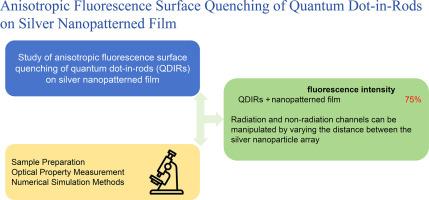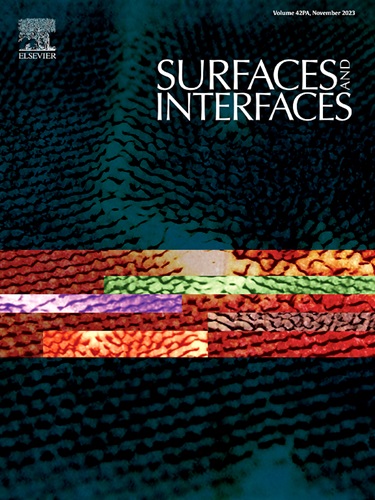Anisotropic fluorescence surface quenching of quantum dot-in-rods on silver nanopatterned film
IF 5.7
2区 材料科学
Q2 CHEMISTRY, PHYSICAL
引用次数: 0
Abstract
Semiconductor quantum dot-in-rods (QDIRs) have served in the broad applications such as luminescent applications, sensor technology, quantum information processing, due to their polarized emission and polarized absorption characteristics. The localized surface plasmon resonance (LSPR) characteristics of the noble metal nanostructures can regulate the fluorescence intensity by controlling the radiation and non-radiation channels of fluorescent substances. However, the reports on the fluorescence surface quenching of QDIRs by plasmonic nanoparticles (NPs) are very rare. Herein, we propose a new method to realize QDIRs orientation, as well as the fluorescence intensity can be regulated. The effect of Ag nanopatterned film on the fluorescence surface quenching of QDIRs is discussed from both theoretical and experimental perspectives. Generally, the direct combination of Ag nanopatterned film and QDIRs results in 75% fluorescence surface quenching. Through FDTD simulation, we further analyzed the modulation of fluorescence intensity of the dipole source by the Ag nanopatterned film. This work will be useful for the development of QDIRs in the future.

银纳米图案薄膜上量子点内棒的各向异性荧光表面淬灭
半导体量子点棒(QDIRs)因其极化发射和极化吸收特性,在发光应用、传感器技术、量子信息处理等领域有着广泛的应用。贵金属纳米结构的局部表面等离子体共振(LSPR)特性可以通过控制荧光物质的辐射和非辐射通道来调节荧光强度。然而,关于质子纳米粒子(NPs)对 QDIRs 荧光表面淬灭的报道却非常罕见。在此,我们提出了一种实现 QDIRs 定向以及荧光强度可调的新方法。我们从理论和实验两个角度讨论了银纳米图案膜对 QDIRs 荧光表面淬灭的影响。一般来说,银纳米图案膜与 QDIRs 直接结合会导致 75% 的荧光表面淬灭。通过 FDTD 仿真,我们进一步分析了银纳米图案薄膜对偶极源荧光强度的调制。这项工作将有助于未来 QDIRs 的开发。
本文章由计算机程序翻译,如有差异,请以英文原文为准。
求助全文
约1分钟内获得全文
求助全文
来源期刊

Surfaces and Interfaces
Chemistry-General Chemistry
CiteScore
8.50
自引率
6.50%
发文量
753
审稿时长
35 days
期刊介绍:
The aim of the journal is to provide a respectful outlet for ''sound science'' papers in all research areas on surfaces and interfaces. We define sound science papers as papers that describe new and well-executed research, but that do not necessarily provide brand new insights or are merely a description of research results.
Surfaces and Interfaces publishes research papers in all fields of surface science which may not always find the right home on first submission to our Elsevier sister journals (Applied Surface, Surface and Coatings Technology, Thin Solid Films)
 求助内容:
求助内容: 应助结果提醒方式:
应助结果提醒方式:


